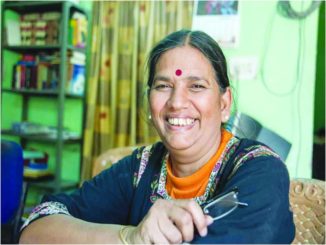
ROCHESTER, NY (TIP): Indian American chemical engineer Poornima Padmanabhan, who is searching for the origins of life based on minute systems of molecules, has received a National Science Foundation Faculty Early Career Development (CAREER) award. An assistant professor chemical engineering at Rochester Institute of Technology (RIT), Padmanabhan was given the five-year, $478,476 award to discover how chiral structures—or mirror-image, entangled molecules—function, according to an RIT press release.
This process is essential to understanding how different cell types are formulated in biochemical development, the Rochester, New York-based private research university said. The concepts can provide information about how synthetic materials can be further developed for use in the pharmaceutical industry, in agriculture or food analysis, and in the development of novel materials to enhance sensing and imaging applications, it said.
Padmanabhan received the award from the NSF’s division of Materials Research for her study titled “Chirality and polymer thermodynamics: frustration and amplification.” Chirality means “handed-ness” and anything in nature that can be identified as right- or left-handed are essentially mirror images.
Polymers are long molecules made from smaller entities that are bonded together. When these smaller entities are chiral, they form much larger chiral polymers, such as proteins which become the building blocks of life systems. In turn, hundreds or thousands of polymers can come together to form even larger structures.
“We can think about how proteins fold, how life originated, we can think about how biology forms chiral structures and the reason the work is very exciting is we don’t know how these phenomena happen,” said Padmanabhan.
In chemical systems where complex interactions lead to formation of molecular structures at a multitude of length scales, chirality may or may not result in each of those length scales.
“We cannot predict when something will be frustrated or when something will be amplified. That is what we are trying to discover with this work,” she said.
Understanding when and how chirality is transferred from the smallest to the largest length scale will be explored by studying the underlying thermodynamic principles and interrogating the molecular-level detail.
A thermodynamic understanding of conditions when such transfer is amplified, or conditions when such transfer is hindered, remain unknown, but through discovery, the information can be used to build artificial systems that mimic biology for engineering applications, she added.
“One cool part about chirality which was a total surprise—and we still don’t know why this is true—many of the biological molecules in our body are all of one type of chirality,” said Padmanabhan, who has been at RIT since 2017.
“At some point early on, during evolution, something about the thermodynamics of the system led us down this one single path. We don’t know why. It’s so crazy how these amazing things are observed.” At RIT, she is co-director of the Computational Materials Research Nucleus Lab which researches development of “extreme” strength polymers, electrochemistry, and alternative energy resources. Prior to coming to RIT, she was a post-doctoral researcher at Cornell University and received its Alice H. Cook and Constance E. Cook Award, given by the Office of Faculty Development and Diversity for commitment to women’s issues and improving the climate for women at the university. Padmanabhan continues to be an advocate for gender diversity and increasing the pipeline of students in STEM degree programs, the release said. The CAREER program is an NSF-wide activity that offers awards in support of junior faculty who exemplify the role of teacher-scholars through outstanding research, excellent education, and the integration of education and research within the context of the mission of their organizations.





Be the first to comment